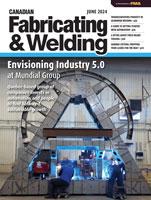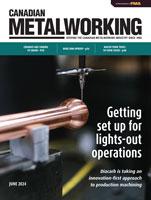- FMA
- The Fabricator
- FABTECH
- Canadian Metalworking
Clean, dry and steady: The fundamentals of good metrology
Keep your CMM repeatable with good installation practices.
- By Jim Anderton
- February 26, 2013
- Article
- Measurement
Taking care of precision measuring instruments is one of the first skills taught to every machining apprentice, for good reason. They were once expensive relative to wages and a dropped “mike” or vernier caliper risked a serious investment.
Scale up the measuring task to today’s coordinate measuring machines and that principle still holds true: they’re expensive and need care to perform reliably. Modern CMM’s are much more rugged than early machines, but basic principles of care and feeding are still relevant today.
Location of the equipment is the first factor to consider. CMM’s are moving from their traditional place front and centre in the QC lab to end-of-line and open shop environments. The basic measuring principles however, are the same so the standard rules for maximizing repeatability in service still apply. A solid, level surface for mounting is important for larger machines. The original mounting points for the equipment should be used to set and level the unit. Shims should be avoided.
Vibration is not as serious a problem as production equipment has moved to servo drives and away from mechanical presses, but location near known sources, such as vibratory part feeders is poor practice, especially if harmonics can be transmitted easily through a floor or wall. Even steel air lines are a possible conduit for vibration if rigidly mounted near the instrument. A short lengthof rubber or polymer airline with sufficient slack should form the final coupling to the unit.
Air is the working fluid of larger machines...that massive bridge floats on an air bearing requiring clean, dry air for smooth, friction-free operation. Large production equipment is more tolerant of poor air quality, and as importantly, the bulk oil injected downstream from the condenser or desiccant pack must be kept away from the instrument. Air requirements for CMM’s are very low by production standards; it may be cheaper to use a small stand-alone compressor rather than engineer a special loop for lab quality air.
Electric power is a similar situation. Computers used in most machines use familiar off-the-shelf hardware, so the same rules for reliable current apply for the CMM as they do for a CAD suite or office desktop. Shop floor environments, especially in older shops, are notorious for unbalanced loads in low voltage single phase circuits. Tapping a local 115VAC circuit is convenient, but shop floor loops have numerous intermittent loads and since major machines are powered from three-phase circuits, few bother to check regulation on the low voltage side. Simple insurance is to run a line from the office circuit or dedicate a breaker to the unit or QC lab. A simple panel meter can be added to a junction box or surface-mount loop to remove doubt. Analog meters also detect transients and dropouts effectively at very low cost.
Most modern computer driven equipment is networked, and standard rules regarding network security should apply for a CMM. If hard wiring a LAN, however, it’s important to remember that some shop floor environments use very high current circuits and frequently power transformers that can affect the data stream. Locate the data cabling well away from any possible inductive coupling with power circuits and remember that shorter is better for wired runs. Avoid looping and tying off excess cabling, and run it to the machine so that the cable can‘t be damaged or pulled in service; most failures occur at the connector. Broken connectors, often taped into place are a warning sign that action should be taken.
Protection from dust and grit should be a given, yet a surprising number of shops won’t add a $2000 prefab cubicle to their investment in a $75,000 (or more) machine. Similarly, if the instrument is exposed, what happens if a sprinkler triggers or a hydraulic line leaks? Guarding against mechanical shock is also often overlooked. Fork lifts and tow motors are a constant threat, as are pallet trucks and overhead hoists. Railings are cheap insurance and also clearly define a no-go area where skids and product must not be stored. While fire is unlikely, Halon-type extinguishers won’t flood the instrument or blow soda into the mechanism.
When sourcing new equipment, it may be simpler to use instruments designed for rugged shop floor use, but in every case, good installation and maintenance practice makes trouble- shooting much easier by removing multiple potential issues. Use a level, solid base, provide clean air and power, then protect the instrument from environmental threats and your CMM will run longer between repair and overhaul and hold calibration between inspections...as well as demonstrate your commitment to total quality management as well as quality production.
About the Author
subscribe now


Keep up to date with the latest news, events, and technology for all things metal from our pair of monthly magazines written specifically for Canadian manufacturers!
Start Your Free Subscription- Trending Articles
5 benefits of non-contact systems that detect broken tools

Creating local and global excellence at Précision SFTech

Haimer USA names new COO and VP of marketing

Sciaky EBAM-made part lands on moon in IM-1 mission lander’s engine

Bobcat breaks ground for Mexico manufacturing facility

- Industry Events
IMTS 2024
- September 9 - 14, 2024
- Chicago, IL
WiM Summit 2024
- October 6 - 9, 2024
- Boston, MA
FABTECH 2024 Orlando
- October 15 - 17, 2024
- Orlando, FL

















